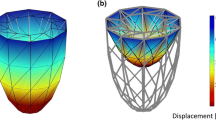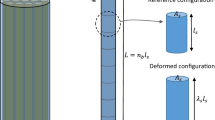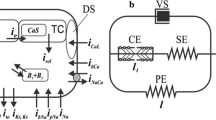Abstract
We utilized our earlier developed 1D mathematical model of the heart muscle strand to study contribution of the bilateral interactions between excitation and contraction on the cellular and tissue levels to the local and global myocardium function. Numerical experiments on the model showed that an initially uniform strand, formed on the inherently identical cells, became functionally heterogeneous due to the asynchronous excitation via the electrical wave spread. Mechanical interactions between the cells and the mechano-electric feedback beat-to-beat affect the functional characteristics of coupled cardiomyocytes further, adjusting their electrical and mechanical heterogeneity to the activation timing. Model simulations showed that functional heterogeneity increases with an enlarged spatial extension of the myocardial strand (in terms of the longer slack length not a higher stretch of the strand), demonstrating a special role of the heart size in its function. Model analysis suggests that cooperative mechanisms of myofilament calcium activation contribute essentially to the generation of cellular functional heterogeneity in contracting cardiac tissue.










Similar content being viewed by others
References
Conte SD, De Boor C (1980) Elementary numerical analysis: an algorithmic approach. McGraw-Hill, New York
Dhillon PS, Gray R, Kojodjojo P, Jabr R, Chowdhury R, Fry CH, Peters NS (2013) Relationship between gap-junctional conductance and conduction velocity in Mammalian myocardium. Circ Arrhythm Electrophysiol 6:1208–1214
Henriquez CS (2014) A brief history of tissue models for cardiac electrophysiology. IEEE Trans Biomed Eng 61:1457–1465
Izakov V, Katsnelson LB, Blyakhman FA, Markhasin VS, Shklyar TF (1991) Cooperative effects due to calcium binding by troponin and their consequences for contraction and relaxation of cardiac muscle under various conditions of mechanical loading. Circ Res 69:1171–1184
Jahnke T, Lubich C (2000) Error bounds for exponential operator splittings. BIT Numer Math 40:735–744
Jeyaraj D et al (2007) Mechanoelectrical feedback as novel mechanism of cardiac electrical remodeling. Circulation 115:3145–3155
Jie X, Gurev V, Trayanova N (2010) Mechanisms of mechanically induced spontaneous arrhythmias in acute regional ischemia. Circ Res 106:185–192
Katsnelson LB, Nikitina LV, Chemla D, Solovyova O, Coirault C, Lecarpentier Y, Markhasin VS (2004) Influence of viscosity on myocardium mechanical activity: a mathematical model. J Theor Biol 230:385–405
Katsnelson LB, Sulman TB, Solovyova OE, Markhasin VS (2009) Cooperative mechanisms of thin filament activation and their contribution to the myocardial contractile function: Assessment in a mathematical model. Biophysics 54:39–46
Katsnelson LB, Sulman T, Solovyova O, Markhasin VS (2011) Role of myocardial viscoelasticity in disturbances of electrical and mechanical activity in calcium overloaded cardiomyocytes: mathematical modeling. J Theor Biol 272:83–95
Katsnelson LB, Vikulova NA, Kursanov AG, Solovyova OE, Markhasin VS (2014) Electro-mechanical coupling in a one-dimensional model of heart muscle fiber. Russ J Numer Anal Math Model 29:275–284
Keener JP, Sneyd J (2009) Mathematical physiology: I: cellular physiology. Springer, New York
Keldermann RH, Nash MP, Gelderblom H, Wang VY, Panfilov AV (2010) Electromechanical wavebreak in a model of the human left ventricle. Am J Physiol Heart Circ Physiol 299:H134–H143
Killeen MJ, Sabir IN, Grace AA, Huang CLH (2008) Dispersions of repolarization and ventricular arrhythmogenesis: lessons from animal models. Prog Biophys Mol Biol 98:219–229. doi:10.1016/j.pbiomolbio.2008.10.008
Kuijpers NH, ten Eikelder HM, Bovendeerd PH, Verheule S, Arts T, Hilbers PA (2007) Mechanoelectric feedback leads to conduction slowing and block in acutely dilated atria: a modeling study of cardiac electromechanics. Am J Physiol Heart Circ Physiol 292:H2832–2853
Li W, Kohl P, Trayanova N (2004) Induction of ventricular arrhythmias following mechanical impact: a simulation study in 3D. J Mol Histol 35:679–686
Markhasin VS, Solovyova O (2005) Mechano-electrical heterogeneity in physiological function of the heart. In: Kohl P, Sachs F, Franz MR (eds) Cardiac mechano-electric feedback and arrhythmias: from pipette to patient. W.B. Saunders, pp 198–207
Markhasin VS, Balakin A, Protsenko Y, Solovyova O (2011) Activation sequence of cardiac muscle in simplified experimental models: relevance for cardiac mechano electric coupling. In: Kohl P, Sachs F, Franz MR (eds) Cardiac mechano-electric feedback and arrhythmias: from pipette to patient. Oxford Press, Oxford, pp 153–159
Markhasin VS, Balakin AA, Katsnelson LB, Konovalov P, Lookin ON, Protsenko Y, Solovyova O (2012) Slow force response and auto-regulation of contractility in heterogeneous myocardium. Prog Biophys Mol Biol 110:305–318
Nash MP, Panfilov AV (2004) Electromechanical model of excitable tissue to study reentrant cardiac arrhythmias. Prog Biophys Mol Biol 85:501–522
Noble D, Varghese A, Kohl P, Noble P (1998) Improved guinea-pig ventricular cell model incorporating diadic space, I\(_{Kr}\) and I\(_{Ks}\), and length- and tension-dependent processes. Can J Cardiol 14:123–134
Quinn TA, Kohl P, Ravens U (2014) Cardiac mechano-electric coupling research: fifty years of progress and scientific innovation. Prog Biophys Mol Biol 115:71–75
Shaw RM, Rudy Y (1997) Ionic mechanisms of propagation in cardiac tissue. Roles of the sodium and L-type calcium currents during reduced excitability and decreased gap junction coupling. Circ Res 81:727–741
Solovyova O et al (2003) Mechanical Interaction of heterogeneous cardiac muscle in silico: effects on \(\rm {Ca}^{2+}\) handling and action potential. Int J Bifurcat Chaos 13:3757–3782
Solovyova O, Vikulova N, Konovalov P, Kohl P, Markhasin VS (2004) Mathematical modelling of mechano-electric feedback in cardiomyocytes. Russ J Numer Anal Math Model 19:331–351
Solovyova O et al (2006) Activation sequence as a key factor in spatio-temporal optimization of myocardial function. Philos Trans A Math Phys Eng Sci 364:1367–1383
Sulman T, Katsnelson LB, Solovyova O, Markhasin VS (2008) Mathematical modeling of mechanically modulated rhythm disturbances in homogeneous and heterogeneous myocardium with attenuated activity of \({\rm {Na}^{+}}-{\rm {K}^{+}}\) pump. Bull Math Biol 70:910–949
Taggart P, Sutton PM (1999) Cardiac mechano-electric feedback in man: clinical relevance. Prog Biophys Mol Biol 71:139–154
Trayanova N, Li W, Eason J, Kohl P (2004) Effect of stretch-activated channels on defibrillation efficacy. Heart Rhythm 1:67–77
Acknowledgments
This work was supported by The Russian Science Foundation (#14-35-00005).
Author information
Authors and Affiliations
Corresponding author
Electronic supplementary material
Below is the link to the electronic supplementary material.
Rights and permissions
About this article
Cite this article
Vikulova, N.A., Katsnelson, L.B., Kursanov, A.G. et al. Mechano-electric feedback in one-dimensional model of myocardium. J. Math. Biol. 73, 335–366 (2016). https://doi.org/10.1007/s00285-015-0953-5
Received:
Revised:
Published:
Issue Date:
DOI: https://doi.org/10.1007/s00285-015-0953-5
Keywords
- Cardiac excitation-contraction coupling
- Mechano-electric feedback
- Heterogeneous myocardium
- Mathematical modeling




